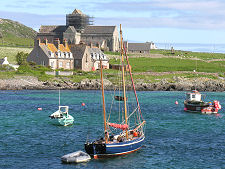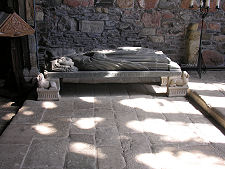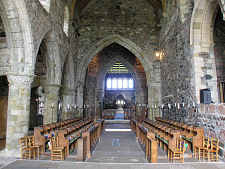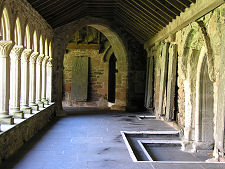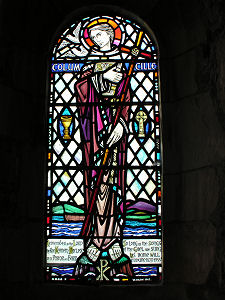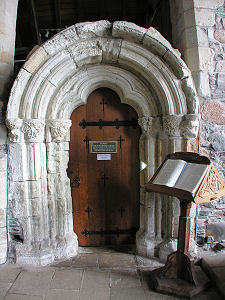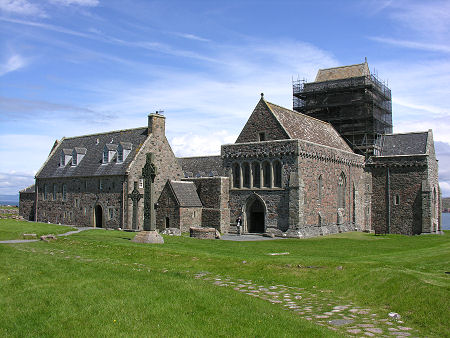 Iona Abbey from the South-West |
Iona has been at the heart of Scotland's religious life since St Columba landed here from Ireland in AD563 and founded a monastery that was to become one of the most important in Europe. A later abbot, Adomnán of Iona, was almost equally venerated. Viking raiders attacked in 795, 802, 806 and 825. During the second raid they burned down the original wooden Columban monastery, located a little to the north of today's abbey, and killed most of the monks. From 818 a replacement monastery was built, this time in stone, on the site of today's abbey. But this in turn was badly damaged during the Viking raid of 825, and in 849 the monastery's surviving relics and valuables were dispersed for safety to Dunkeld Cathedral in Perthshire and to Kells in Ireland.
Despite this, the abbey graveyard, Relig Odhráin, continued to serve as the burial place of Scottish kings, a tradition that persisted until the death of Macbeth in 1057. A survey conducted in 1549 listed 48 Dalriadan/Scottish kings buried here, as well as 8 Norwegian and 4 Irish kings. Perhaps because of this, Queen Margaret attempted to restore the abbey to full use from 1074, but with limited success.
In about 1200, Reginald MacDonald of Islay, one of the sons of Somerled, decided to revive the old traditions and turn Iona into a centre of Christianity important enough to rival anything on the Continent. What was left of the Columban monastery was replaced with a very much grander Benedictine Monastery built on the same site. Reginald also built an Augustinian Nunnery on the island.
Further building work throughout the 1400s resulted in numerous changes to the abbey, and in particular to the abbey church: though work on a huge new south transept, which would have been as long as the nave and twice its width, was was abandoned soon after it was started. This had been intended to allow more space in which the ever-growing stream of pilgrims to Iona could worship.
Everything came to a grinding halt as a result of Scotland's "Cultural Revolution": the Reformation of 1560. Iona Abbey's remote location did not save it from falling into disuse and dereliction in the aftermath of the Reformation, though it may have helped save the abbey from being used as a quarry for later nearby building work, a fate that awaited many of Scotland's great abbeys.
An indication of the scale of the vandalism resulting from the Reformation was the disappearance of 357 of Iona's famous stone crosses in the years that followed: leaving only a handful on view today, including those in the Infirmary Museum.
There was an effort by Charles I to use the east end of the abbey church as a Cathedral of the Isles in the 1630s but this failed, and over the following two hundred years the abbey became a ruin. Despite this, the island's essential spirituality persisted. A visitor in 1773, Samuel Johnson, commented: "That man is little to be envied, whose patriotism would not gain force upon the plain of Marathon, or whose piety would not grow warmer among the ruins of Iona".
The abbey as you see it today is largely due to the vision of the 8th Duke of Argyll. In 1874 he commissioned the architect Robert Rowand Anderson to preserve the Abbey ruins. The real turning point came in 1899, when he transferred ownership of the Abbey, the Nunnery, St Oran's Chapel and Relig Odhráin, to the Iona Cathedral Trust.
Restoration of the Abbey Church began in 1902 and work on the nave was complete in 1910. In 1938 the Reverend George MacLeod founded the Iona Community. This set itself the task of returning the other monastic buildings back to use. By 1965 this had been done, including the building of a new west range to the cloister as the original had never been completed.
Today the Iona Community works on the island and far beyond it for social and political change. It runs three residential centres on Iona, one of which is at the Abbey itself. This means that while it attracts and caters for a huge number of visitors, the Abbey is also a working religious community. The doors discreetly marked as only for residents' use remind you of this.
The visitor approaching Iona Abbey from the ferry comes first to the Relig Odhráin, St Oran's Chapel. Beyond are the grounds of the abbey, complete with the Historic Environment Scotland reception kiosk. Having made your way past the standing crosses to the abbey complex itself, perhaps the most striking element is the cloister, simply because it is a structure so rarely seen, in complete form at least, elsewhere in Scotland. This has been stunningly restored, complete with wonderful modern carvings and, at its centre, the large bronze sculpture The Descent of the Spirit by Lithuanian Sculptor Jacques Lipchitz.
Leading off the east side of the cloister is the restored chapter house, while in the north-west corner you find the modern abbey shop. Here, below the upper floors in use by the Iona Community, you really get a feeling of being part of a living building. To the south of the cloister is the abbey church. This, too, is a beautiful and contemplative space, and again you get a sense of life so often absent from old buildings. Especially striking are the marble effigies of the 8th Duke of Argyll and his wife: the man whose vision restored Iona Abbey.
Elsewhere within the complex, visitors are able to visit the Michael Chapel, and the Infirmary Museum. This museum houses a range of early gravestones and a stone pillow thought to have been used by St Columba himself. Also here are the original remnants of the stone crosses that remained after the Reformation. Replicas have been made of some of these, and placed in their original locations.
It's unnecessary to say that no visit to Iona is complete without a tour of the abbey: because that is what just about every visitor does. But make sure you don't miss the easy-to-overlook Infirmary Museum and the Michael Chapel, or St Oran's Chapel and Relig Odhráin. And remember that having seen the wonders of the abbey there is the rest of this beautiful island to explore as well.
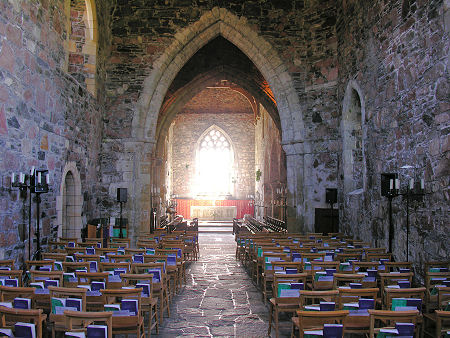 The Abbey Church: Looking East from the Nave to the Choir |

|
|
|
Visitor InformationView Location on MapSTB 4 Star Historic Attraction. Tel: 01681 700512. Post Code: PA76 6SQ Grid Ref: NM 286 2452 www.historicenvironment.scot HES: Abbey Web Page Opening Hours Admission Accessibility What3Words Location: ///swept.ties.imprinted |
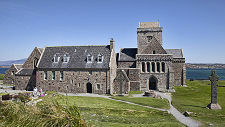 Iona Abbey Minus Scaffolding: May 2012 Image Courtesy Jennie French |
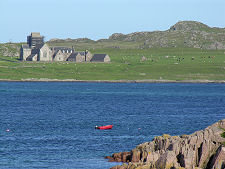 ...And From Mull |
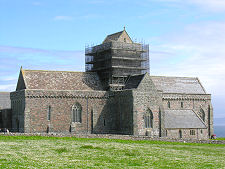 Abbey Church from the South-West |
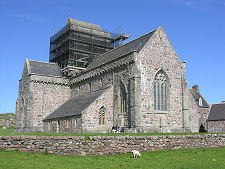 ...And from the South-East |
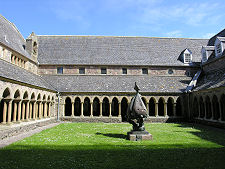 The Cloister |
 Replica of St John's Cross |
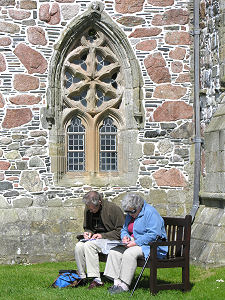 Writing Postcards in the Sunshine |
